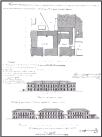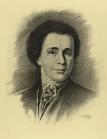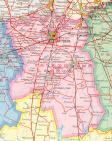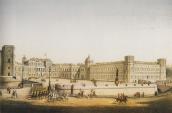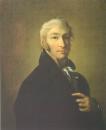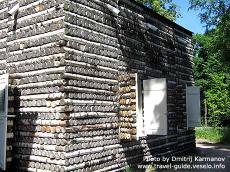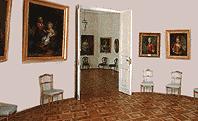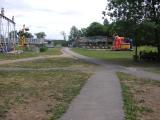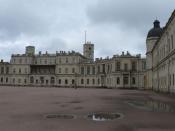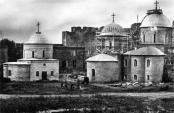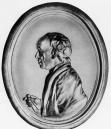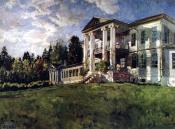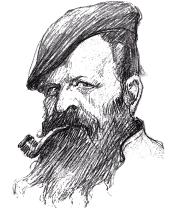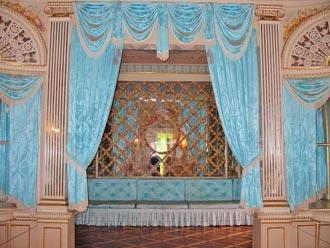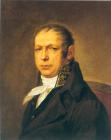Articles
/
Gatchina Palace -and - Park ensemble, the
Gatchina Palace -and - Park ensemble, the
Subject /
Architecture/Palaces
The Gatchina Palace -and - Park ensemble. It is an architectural sight and garden-and -park monument of the 18-19th centuries of federal importance. The ensemble is included in the State Palace-and-Park and Art-and-Historic Culture Preserve "Gatchina". The culture preserve includes palaces, pavilions, bridges, sculpture and other decorative and monumental buildings located on the territory the Palace and Priorate parks. The ensemble creating was started since 1765 when Count G.G. Orlov was the owner of the estate. From 1766 to 1781 the architect A. Rinaldi was building the Grand Palace, its romantic silhouette was determined with two towers (the Signal Tower and Watch Tower, they delimit the central block. The palace central block and two service wings (Building of the Arsenal and Building of the Kitchen) are connected with semicircular galleries. The refind interior decoration (rococo, early classicism) is contrasted with the restrained decoration of facades that are tiled with local Pudost stone. Marble statues are placed by entrances: on the park façade there are statues "Peace" and "War"; from the meadow side (afterwards the meadow was remade as the parade ground) there are statues "Vigilance" and "Wisdom" (sculptors I. Morleyter and D. Markiori). At the same time on the shores of Beloye (White) and (Serebryanoye) Silver lakes the English Garden was laid out by gardenrs D. Bush, D. Geket and others. For the first time in Russia the natural landscape planning was used in Gatchina. It was the latest word in the gardening of that time. Artificial small islands were made on Beloye Lake, the shore line was cut with picturesque bays, alleys and clearings were laid in the park. First decorative structures: "Eagle" column, Chesmensky obelisk, grotto "Echo" decorated the underground passage from the Grand Palace to Silver Lake were created in the English Garden in the 1770s and become its natural part. Since 1783, when Grand Duke Pavel Petrovich (since 1796 - Emperor Pavel I) became the owner of Gatchina, considerable changes had occurred. New plots were connected to the park. They were laid out in the regular style: with cut espalier, decorative marble sculptures, geometrical planning of pathes and lawns: they were at the Palace Gardens (the Private Garden, Upper Holland Garden, Lower Holland Garden), the Botanic Gardens, Silvia Grove. A water labyrinth, the artificial Carp Pond, several bridges, park gates (Admiralty Gate, Birch Gate, Sivia Gate) were created. Among pavilions appeared in the park there was the wooden Pavilion of Venus on the Island of Love, "Birch House" (the artist F. Violye) in the form of a pile of logs decorated with the 16-column Portal "Mask", the Temple or "Eagle" Pavilion, stone Greenhouse. On the Long Island (it is an archipelago of small islands divided White Lake) the Great Terrace - pier was built. In vista it looks like the socle of the Grand Palace. Rebuilding and changing the interiors of the Grand Palace and park structures were made according to the projects of V. Brenna in the 1790s. On the shore of Black Lake in 1797-1799 the Priorate Palace, "Earth Monastery", which is the unique object of monumental rammed-earth construction, was built on the project of the architect N.A. Lvov. At the same time the landscape Priorate park was laied out by gardenings D. Geket and F. Gelmgolts. Territories of two parks are separated with Bolshaya Porkhovskaya doroga (Great Prkhov Road) (now it is the prospekt of 25 October) on which bridges: the Three-arched Lion Bridge and the Admiralty Bridge with a stone balcony and guard sentry-boxes, the Connetable square with 32-metre colimn (by the craftsman K. Plastilin were constructed. These constructions and the Grand Palace form the ensemble. The parade ground in front of the western façade of the Grand Palace is encircled with the bastion wall and ditch, in Yekateringof (now Krasnoarmeysky) prospekt stone Palace stable were built. In 1800 on the Long Island the Venetian Humpbacked Bridge was constructed by A.D. Zakharov's project. Somewhat earlier in Silvia Grove on the North-West from the English Garden the pavilion "Poultry-yard" was built on the project of the architect A.D. Zakharov. On the boundary of Silvia Grove the earth structure Amphitheatre, near the pavilion "Poultry-yard" the cascade "Naumakhia", the pavilion "Farm" were built. Amphitheatre and "Naumakhia" were built on the project of the architect N.A. Lvov. The pavilion "Farm", the pavilion of Venus, the Palace stable and some others were built on architectural models that Paul I saw in Chantilly, the estate of Princes de Conde. During the 19th century there were not considerable changes in the ensemble. New Iron bridges, brick sentry-boxes at the entrances into the parks were built in the 1880s on the project of the architect L.F. Shperer. Repair works were acrried out in the Grand Palace, in the 1859s new wings - the Arsenal and the Kitchen were built on the project of the architect R.I. Kuzmin, the monument to Paul I was stood on the parade ground in 1851 on the project of the sculptor I.P. Vitali. After the Revolution of 1917 country residences were declared as palaces-museums, parks were used for different types of cultural work among the masses. In contrast to the Palace park that is connected with the museum complex, the Priorate Palace and park had lost their museum significance before the World War II, an excursion centre and recreation centre were placed there (after the war the city pioneer centre was placed in the palace; later till 1982 in the palace the Local History Museum was placed there). During the time of the German occupation if Gatchina town from 1941 till 1944 the ensemble had extensive damage. In January 1944 thee fire destroyed interiors of the Grand Palace and other constructions. The Priorate Palace was mined by fashists but came off unhurt. The majority of park constructions (with the exception of several exploded bridges) were unharmed. During the last years restoration works were carried out in the parks. In 1976 the pavilion Birch House (according the project of the architect A.A. Kedrinsky) was restored. The Arched Bridge, "Eagle" column and pavilion, marble statues on the Great Terrace-pier: "Painting", "Architecture", "Mathematics" (two statues were lifted from the bottom of White Lake in 1971; now they are on the museum exhibition of the Grand Palace). In the 1990s the Admiralty bridge, Lion bridge and Carp bridge with cascade were restored. First restored halls of the Grand Palace opened in 1985. In 2005 the overhaul restoration of the Priorate Palace that became a part of the State Palace-and-Park and Art-and-Historic Culture Preserve "Gatchina" was completed. But a lot of constructions that were restored in the 1950s-1970s during last years were destroyed by modern vandals.
Authors
Piryutko, Yuri Minayevich
Persons
Brenna, Vikenty (Vincenzo) Frantsevich
Bush, Joseph (John)
Geket, James
Helmholtz, Fyodor
Kedrinsky, Aleksandr Aleksandrovich
Kuzmin, Roman Ivanovich
Lvov, Nikolay Aleksandrovich
Lvov, Nikolay Aleksandrovich
Markiori, Giovanni
Morleyter, Johann-Maria
Orlov, Grigory Grigoryevich, Count
Paul I, Emperor
Plastinin, Kiryan
Rinaldi, Antonio
Schperer, Ludwig Frantsevich
Violie, Francois-Heinrich
Vitali, Ivan Petrovich
Zakharov, Andreyan (Adrian) Dmitriyevich
Geography
Leningrad Oblast, the/Gatchina District/Gatchina Town/25 Oktyabrya Prospekt (25 October Prospekt)
Leningrad Oblast, the/Gatchina District/Gatchina Town/Beloye Lake (White Lake)
Leningrad Oblast, the/Gatchina District/Gatchina Town
Leningrad Oblast, the/Gatchina District/Gatchina Town/Krasnoarmeysky Prospekt (Red Army Prospekt)
Topographical landmarks/Serebryanoye Lake
Bibliography
Макаров В.К., Петров А.Н. Гатчина. Изд. 2-е. СПБ., 2006
Минкина Г.А., Мамаев К.К. Гатчинский парк. Л., 1956
Пирютко Ю. М. Гатчина: Художественные памятники города и окрестностей. 2-е изд., испр. и доп. Л., 1979
Елкина А.С. Гатчина. – Л.: Художник РСФСР, 1980.
Кючарианц Д. А., Раскин А. Г. Гатчина: Худож. памятники. СПб., 2001
Subject Index
"Gatchina", the State Museum-Reserve
Palace Park (the town of Gatchina)
Priorate Palace, the
Priorate Park (the town of Gatchina)
"Silvia", a park (the town of Gatchina)
Mentioned in articles:
|
hidden
|
Albreht, Karl Frantsevich (1807- 1863), a misician
ALBRECHT, Karl Frantsevich (1807–1863, Gatchina Town), violinist, composer, choirmaster, teacher. He was born in Prussia where he obtained musical education. In the period 1825-38 he worked as a violinist and a conductor at different choirs and... more
|
|
|
|
hidden
|
Baikov, Aleksey Mikhaylovich (1791- 1854), an architect
Aleksey Mikhaylovich Baikov (1790-1854), an architect, a graduate of the St. Petersburg Academy of Arts (1813). From 1816 he was an architect of the Gatchina Town Board, from 1843 he was an architect of the Gatchina palace board. During 40 years... more
|
|
|
|
hidden
|
Bazhenov, Vasily Ivanovich (1737/38 - 1799), an architect
Vasily Ivanovich Bazhenov (1737 or 1738 - 1799), an architect, one of the Russian classicism founder. From 1756 to 1762 he learned in the St. Petersburg Academy of Arts and the Royal Academy in Paris. Since 1765 Bazhenov had been an academician and... more
|
|
|
|
hidden
|
Brenna, Vikenty Frantsevich (1745 -1819 or 1820?), architect
Vincenzo Brenna (1745-1819/1820?), an architect and scene painter, a representative of classicizm. He was of Italian origin. From the end of 1783 Brenna worked in Pavlovsk, at first as an assistant of Charles Cameron. Brenna's main work is the... more
|
|
|
|
hidden
|
Gatchina District
GATCHINA DISTRICT, municipal entity. Population: 111,600. Area: 2850.3 sq. km. Established in 1927. Due to renaming of Gatchina Town, it was called Trotsk District in 1927-29, and Krasnogvardeisk District in 1929-44.Gatchina district borders with... more
|
|
|
|
hidden
|
Gatchina, town
GATCHINA (Trotsk in 1923-27, Krasnogvardeisk in 1927-44), a town in Leningrad Oblast, adm. center of Gatchina District. Population: 82,900 (the largest town in the Leningrad Oblast.) First mentioned in the Novgorod scribe roll of 1499 -1500 as... more
|
|
|
|
hidden
|
Karamzin, Nikolay Mikhaylovich (1766-1826), a literary man, scholar
Karamzin, Nikolay Mikhaylovich (1766-1826), a writer, publicist, historian, honorary member of the St.Petersburg Academy of Sciences (1818), full state councillor (1824). Karamzin was educated at the private boarding school in Simbirsk City, then... more
|
|
|
|
hidden
|
Kedrinsky, Aleksandr Aleksandrovich (1917 - 2003), an architect
Aleksandr Aleksandrovich Kedrinsky (1917 - 2003), an architect-restorer, Honoured architect of the Russian Federation, the Lenin Prize winner of 1986, the Russian Federation President Prize winner in Literature and Arts of 2001. A.A. Kedrinsky was... more
|
|
|
|
hidden
|
Krylov, Ivan Andreyevich (1769-1844),
Krylov, Ivan Andreyevich (1769, according to the other data 1766 or 1768 - 1844), a writer of fables, playwright, journalist, a full member of the Russian Academy of Sciences, academician of the St. Peterburg Academy of Sciences from 1841, state... more
|
|
|
|
hidden
|
Makarov, Vladimir Kuzmich (1885-1970), a museum worker
Makarov, Vladimir Kuzmich (1885-1970), a museum worker, Doctor of Arts. He graduated from the historic and philological faculty of the St. Petersburg University. From 1917 V.K. Makarov worked as an assistant at the Hermitage Gallery of Art Jewelry. ... more
|
|
|
|
hidden
|
Parks
Park is a specially plan area with artificially planted trees and with the paths, trails, ponds. The first parks on the territory of the Leningrad Oblast were founded in the 18th century. They were part of imperial residences, grand prince... more
|
|
|
|
hidden
|
Plotnikov, Mikhail Mikhaylovich (1901 - 1992), an architect
Mikhail Mikhaylovich Plotnikov (1901 - 1992), an architect - restorer, the State Prize winner (1972). M.M. Plotnikov graduated from the I.Ye. Perin Institute of Painting, Sculpture and Architecture in 1943. He participated in post- war restoration... more
|
|
|
|
hidden
|
Restoration of buildings of architectural and historic interest.
Restoration of buildings of architectural and historic interest. The first experience of the research restoration of the Russian Middle Ages monuments in the territory of the pesent-day Leningrad Oblast dates from 1846-1847, when in the Ivangorod... more
|
|
|
|
hidden
|
Rinaldi, Antonio (ca. 1709 - 1794), an architect
Antonio Rinaldi (ca. 1709 - 1794), an architect. He originated from italy. From 1752 Rinaldi served under the Hetman of Malaya Russia K.G. Razumovsky (he designed and built in towns of Baturin, Glukhov, Kozelets, Pochep). From 1754 he worked in St.... more
|
|
|
|
hidden
|
Rozhdestveno, a country estate
Rozhdestveno, a country estate (the village of Rozhdestveno, the Gatchina district). In the early 18th century the estate belonged to tsarevitch Aleksey Petrovich. The village's name appeared in 1713 after building the Church of the of the Nativity... more
|
|
|
|
hidden
|
Shcherbov, Pavel Yegorovich (1866-1938), an artist
SHCHERBOV, Pavel Yegorovich (1866 – 1938, Gatchina Town), a graphic artist and caricaturist. He studied at the Academy of Fine Arts (1885-86). In his sharp satiric drawings and watercolours he depicted literary and art life in St.Petersburg in the... more
|
|
|
|
hidden
|
Shubin, Fedot Ivanovich (1740 - 1805), a sculptor
SHUBIN (SHUBNOY), Fyodot Ivanovich (1740–1805), a sculptor. He lived in St.Petersburg since 1759. In the period 1761-67 he studied at the Academy of Fine Arts, his teacher was H.F. Gillet. Shubin lived in Paris (1767-70) and in Rome (1770-72)... more
|
|
|
|
hidden
|
Viollier, Henry-Francois-Gabriel (Frants -Gavriil, 1750 -1829), an artist, architect
Viollier, Henry-Francois-Gabriel (Frants -Gavriil, 1750 -1829), an artist, architect. Viollier was of Swiss origin. He was in Russia from 1776. Till 1791 he served at the "Small court" of Grand Duke Paul Petrovich. Henry-Francois-Gabriel Viollier... more
|
|
|
|
hidden
|
Voronikhin, Andrey Nikiforovich (1759-1814), an architect
Andrey Nikiforovich Voronikhin (1759–1814), an architect. Till 1785 he was a serf of Count A.S. Stroganov. From 1777 Voronikhin learned in Moscow , his teachers were V.I. Bazhenov and M.F. Kazakov. From 1779 he learned in St. Petersburg, his... more
|
|
|
|
hidden
|
Zakharov, Andreyan (Adrian) Dmitriyevich (1761-1811), an architect
Andreyan (Adrian) Dmitriyevich Zakharov (1761-1811), an architect. From 1767 to 1782 he learned at the St. Petersburg Academy of Arts from Yu.M. Felten and A.A. Ivanov. Then till 1786 he learned at Zh.F. Shalgren's workshop in Paris. From 1787 to... more
|
|
|
|










